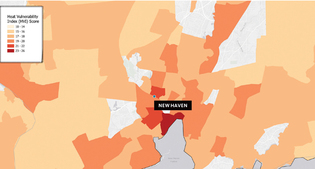
Mitchell Manware
Thanks to carbon dioxide and other greenhouse gases, people all around the world are starting to realize that the future is getting hotter. But will that rise in temperature affect various parts of the US—and the health of locals—differently?
The question intrigued researchers at the Yale Center on Climate Change and Health. Using census tracts and accounting for numerous factors, from the proportion of elderly residents to the amount of green space, they analyzed the areas most likely to struggle. Moreover, they have put the data together in an interactive online map, searchable down to the neighborhood level. (The map is at https://tinyurl.com/mtdxbnzm. The researchers also published a paper in the journal GeoHealth.)
Higher temperatures have been linked to everything from cardiovascular disease to mental disorder, says assistant professor Kai Chen, one of the study’s authors and director of research at the Yale Center on Climate Change and Health. “But simply being hot doesn’t mean a large health burden. For you or me, if it’s hot, we probably stay in the office or at home with the air-conditioning on. That doesn’t equal the actual vulnerability,” he says. “Vulnerability means heat exposure, but also other factors that can reduce your ability to adapt to it.”
Those factors include the health status of the local population—diabetes prevalence, for example. However, they also include urban planning aspects, such as building density, or the proportion of green space. Partly as a result, the most heat-susceptible areas in the United States aren’t in the southern or more tropical states.
One of the most striking findings was how unequally the different neighborhoods are prepared for heat. Racial disparities are especially stark; over three-quarters of residents of the most vulnerable category of census tracts in the US are people of color. Urban areas are especially exposed, with lower-income urban areas the worst off. In New York City, wide swaths of the Bronx score around 40 percent higher on the heat vulnerability index than parts of lower Manhattan or the Upper East Side.
The findings make one takeaway especially clear, says Chen: climate adaptation must happen on a collective level. “When a heat wave comes, the warning you receive is probably ‘Drink more water, stay in the shade,’” he says. “But that’s individual-level protection.” Instead, communities and governments must work to put in evidence-based, population-level adaptation measures—especially tree cover. “These actions,” Chen says, “can really save lives.”
 loading
loading